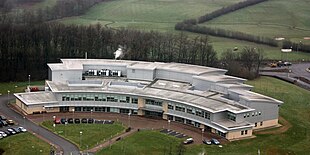Keele University Medical School

School of Medicine building named 'The David Weatherall Building' in 2012 in honour of the retiring Keele University Chancellor
|
|
| Type | Medical school |
|---|---|
| Established | 1978 |
|
Administrative staff
|
80 |
| Students | c.750 |
| Location |
Keele, Staffordshire, England 53°0′22.9″N 2°15′59.3″W / 53.006361°N 2.266472°WCoordinates: 53°0′22.9″N 2°15′59.3″W / 53.006361°N 2.266472°W |
| Affiliations | Keele University |
| Website | Keele Medical School |
 |
|
|
Complete (2018, national) |
9 |
|---|---|
|
The Guardian (2018, national) |
4 |
|
Times/Sunday Times (2017, national) |
4 |
Keele Medical School is a medical school based on campus at Keele University near Newcastle-under-Lyme, Staffordshire, England. The first two years of the school's MBChB course are taught mainly on Keele University campus although early exposure to patients is of importance and in the second year there is considerable interaction in a clinical setting.
Years three to five, however, are principally taught within the Royal Stoke University Hospital in Stoke-on-Trent and the County Hospital (both part of University Hospitals North Midlands Trust), at the Royal Shrewsbury Hospital, Shrewsbury and Telford Hospital NHS Trust, North Staffordshire Combined Healthcare NHS Trust and South Staffordshire and Shropshire Healthcare NHS Foundation Trust. Medical students also have placements in general practices in Staffordshire and Shropshire.
The school originally accepted about 120 UK/EU and 10 non-EU medical students each year for the 5-year MBChB course and 10 UK/EU/non-EU students for the 6-year course. From 2011 the total accepted increased to about 150 from all sources. This number may vary depending on NHS requirements and funding.
The Royal Commission on Medical Education (1965–68) issued its report (popularly known as the Todd Report) in 1968 on the state of medical education in the United Kingdom. The commission estimated that by 1994 there would be a need to train more than 4,500 doctors a year for the United Kingdom, and that this would have to be achieved by both increasing the numbers of medical students at existing medical schools, and establishing a number of new ones. It recommended that new medical schools should be immediately established at the universities of Nottingham, Southampton and Leicester.
...
Wikipedia
